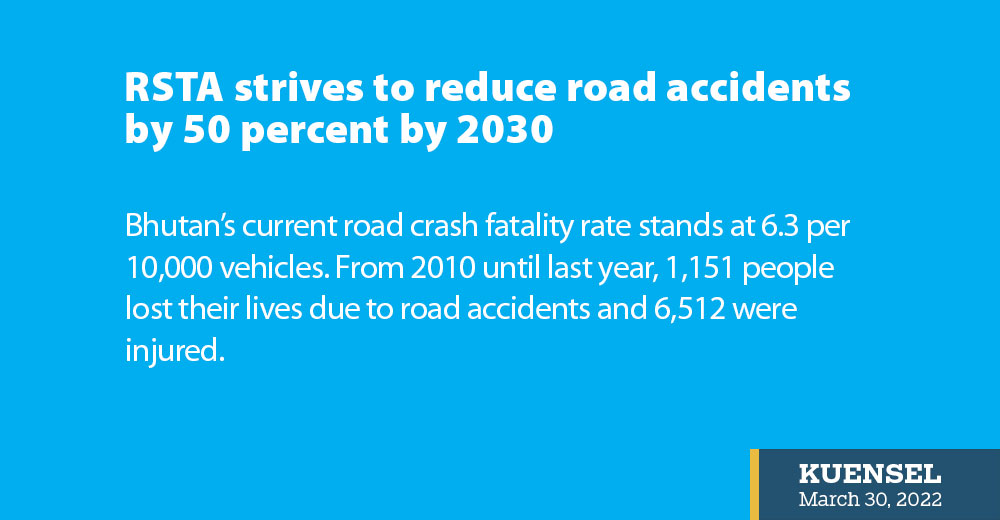Phub Dem
Bhutan’s current road crash fatality rate stands at 6.3 per 10,000 vehicles.
From 2010 until last year, 1,151 people lost their lives due to road accidents and 6,512 were injured.
According to the Ministry of Information and Communications’ statical report, road accidents reduced to 745 last year compared to 811 in 2020 and 1,470 in 2019.
Paro recorded the highest accident (141), followed by Thimphu (131), and Chukha (116).
According to the report, human error (other driving errors) remains the leading cause of motor vehicle accidents, followed by drink driving, speeding and unlicensed or inexperienced driving.Likewise, road conditions and mechanical failures also cause road accidents.
Besides, unlicensed driving, using a cellphone while driving, and drink driving were recorded as significant offences during highway inspections and most significant daily traffic violations.
The Road Safety and Transport Authority (RSTA) aims to reduce fatal and non-fatal vehicle crashes by 50 percent by 2030 in line with the Decade of Action on Road Safety 2021-2030.
According to the Authority, improving road safety that focuses on reducing the number of deaths and injuries is an important goal. “While motor vehicle accidents are unpredictable, most road crashes are preventable.”
The Authority and MoIC enhanced the efforts through safety regulations, sensitising and creating awareness among the road users and ensuring professionalism for the drivers.
RSTA director, Tashi Dawa, said that comprehensive advocacy and awareness programmes would be rolled out through in-person and virtual modes to analyse the factors and trends in road crashes and traffic violations.
He said that the Authority would enhance traffic signages, road markings and early warning of road conditions in collaboration with the Ministry of Works and Human Settlement, Royal Bhutan Police and Local Government.
According to RSTA officials, in the last three years of the Plan, the authority has provided road safety education to more than 14,000 people comprising students, school principals, civil servants, students, truckers, learner license holders, government vehicle drivers, bolero drivers, traffic police, de-suups, taxi drivers, armed force drivers and automobile workshop mechanics. “Road safety guidebook, standard curriculum to conduct road safety and traffic discipline refresher’s course by all RSTA offices and road safety audit guidelines are implemented.”
They said that RSTA procured various enforcement and safety equipment to conduct drug testing for drivers, a pre-departure post-arrival inspection of passenger buses, and frequent maintenance highway inspections to strengthen enforcement of safety regulations. “RSTA became a member of Asia-Pacific Road Safety Observatory (APRSO) last year, which will enable knowledge and experience sharing in the Asia-Pacific region in road safety.”
As responsible drivers determine road safety, chief transport officer, Sithar Dorj, said that RSTA took significant steps in creating a question bank for theory tests, categorisation of driving licenses, standardisation, and strengthening of driving training institutes.
He said that RSTA set up standards and developed infrastructure, workforce, curriculum and equipment for driving training institutes in collaboration with the labour ministry to strengthen and professionalise driving training institutes.
He said that certification of driving training instructors had been instituted in 2021, and the authority has completed training of trainers for 74 driving school instructors and 19 De-Suung Skilling Programme (DSP) training instructors.


